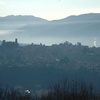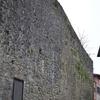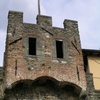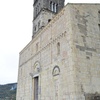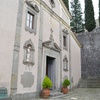Castle of Barga
The old castle of Barga is situated on top of a hill to the southwest of the summit of Mount Renaiolo. The convenient location allows the castle to dominate the valleys of the rivers of Fontanamaggio and Val di Lago, the river of Corsonna and much of the Plain of Gragno.
The highlights of the village are the city walls, the Collegiate Church of St. Christopher, the Church of SS. Crucifix and the Church of San Francisco.
Of the original nucleus of the settlement remain only some parts of the city walls which were once interspersed with circular towers, equipped with cannonade machicolations, of which only one is currently visible in the southern part of the wall.
The Collegiate Church of St. Christopher has a basilica layout with three naves and is located at the summit of the town. The construction of the building began in the 9th century and ended between the 16th and 17th centuries. Among the materials used, blocks of limestone from the quarries of Barga are of particular note.
Inside, of considerable interest, is an ambo (from the second half of the 12th century) decorated with biblical scenes, a polychrome wooden statue of St. Christopher (late 12th century), placed in a niche behind the altar, the chapel of the Blessed Sacrament, embellished with some majolica by Andrea Della Robbia and a panel of St. Joseph (early 16th century), whose background contains an admirable depiction of the town of Barga.
The Church of SS. Crucifix, founded in the 13th century, is one of the oldest places of worship in Barga, and over the centuries a series of alterations have taken place, changing its appearance. The interior has three barrel-vaulted naves decorated with rich stucco. The apse area is characterized by a wooden furnishings imported from Florence, installed during the restructuring of the 17th century.
Notable are the high altar, by Francesco Santini of Cerreto, the 15th century wooden crucifix and many paintings of the Tuscan school of the 17th and 18th centuries.
The Church of San Francesco is the result of proselytizing at the end of the 15th century by the beatified Michele Turignoli and Gaspero of Barga. Michele Turignoli was responsible for the restoration of the ancient monastery of San Francesco carried out between 1471 and 1490.
In the church are several glazed earthenware items, including eight attributed to Andrea Della Robbia and his successors. Also of note is the altarpiece of the Assumption of Mary and two statues of St. Andrew and St. Anthony, dating from 1490. The altarpiece of the Nativity dating back to the beginning of the16th century and one depicting St. Francis Receiving the Stigmata.
Barga had a long history of conflict with Lucca and this tumultuous relationship was responsible for the demolition of the walls in 1298 and the alliance of the village with Florence in 1331. Thanks to its strategic position, it has always been considered important by the Medici of Florence and in the 16th century a bastion was built to make the town defences more effective.



